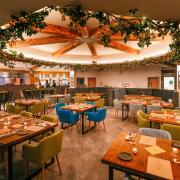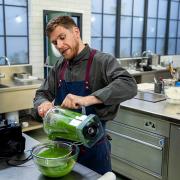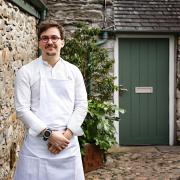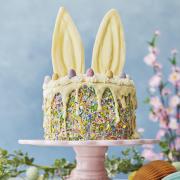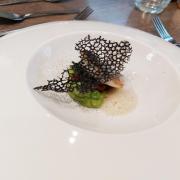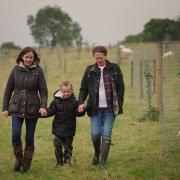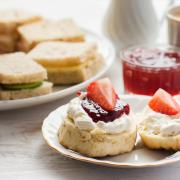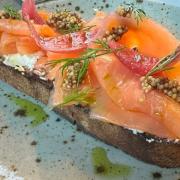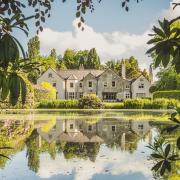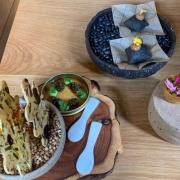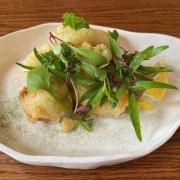Cookery editor Philippa James delves into the history of the Courting Cake
Witton Park near Blackburn was the last pre-nuptial public appearance for Prince William and his then fiancee, Kate Middleton. And, in true Lancastrian spirit, they were presented with a Courting Cake, which in some parts of Lancashire were lovingly baked by the fiancee, and presented to her betrothed as a token of love, care and friendship, following their courtship.
Their cake had been baked by Self Unlimited, a charity for disabled adults which runs a cafe at the sports pavilion in the park; it was heart-shaped and made of two layers of shortbread, sandwiched with raspberry jam, with the couple’s names in icing on the top. It was presented to the couple by Sarah Buckley, one of the young adults studying catering with the charity.
Looking into the history of the Lancashire Courting Cake it is somewhere between a firm sponge - with a greater proportion of flour to fat and eggs than a Victoria sponge cake - and a shortbread base and was proof of the bride-to-be’s baking skills. Like lovers, food and Lancashire go hand-in-hand.
The cake was traditionally filled with lightly bruised, or over-ripe strawberries or raspberries - I suppose akin to many a woman’s heart, slightly bruised, battered, and oft’ times a little past their best by the time they become betrothed!
Looking further into courtship in northern towns where segregation was a big part of life with women in cotton mills and light industry and the men employed in mining and heavy industry, there were designated areas to ‘promenade’, such as Oldham Street in Manchester, known as the Monkey rank, where single young people would walk up and down until they caught someone’s eye.
In Preston, different areas were known for the class of people who would be allowed to frequent the courting zone. This was further pronounced in Chorley where Market Street was known as The Drag, which had a Tanner side for the office girls and clerks and a Tuppence-ha’penny’ one where the factory workers walked out.
But according to Ellen (Nellie) Hitchen, from Chorley, all the girls would gaggle together, irrespective of their working background, and walk up one side then back down the other, eyeing up the boys.
If their sweetheart wasn’t there, he’d be in Howarth’s Cafe, which was so popular that young people would queue up the stairs to get in. Nellie said: ‘If you were really unlucky, by the time you got upstairs to a table, the boy you fancied would have spent his fourpence and the tiny lady owner would have thrown him out of the seat as soon as the cup of tea was empty so another young person would spend their money.’
On Sundays, gangs of young men and women in their best two pieces, a frock and coat, would gather in Astley Park, by the paddling pool, to look out for future partners.
With long working weeks Saturday and Sunday were the days for courtship, but over in east Lancashire it was definitely ‘never on a Friday night’; if a young couple were caught together, the neighbours would alert everyone by banging a frying pan, and the couple would be given a hard time.
Not a fate that Prince William and Kate will have experienced, I’m sure! I wish them many wonderful years of happiness.
Courting Cake Recipe
This is a real summer treat and a good way of using up slightly bruised or over-ripe strawberries or making just a few go further. It was originally made in the North by young girls for their betrotheds, hence the name. Makes about 16 slices
Ingredients
225g/8 oz Butter or sunflower margarine
225g/8 oz Caster or granulated sugar
4 Free-range eggs, lightly beaten
350g/12 oz Self-raising flour
30-45ml/2-3 tbsp Full-fat milk
300ml/10 fl oz Double cream
225g/8 oz Strawberries, sliced
Icing sugar, to decorate
Method
1. Grease and line the bases of three 18 cm (7 inch) round cake tins.
2. Cream the butter and the sugar together until pale and fluffy. Gradually add the eggs, a little at a time, beating well after each addition. Fold in the flour, then add enough milk to give a soft dropping consistency.
3. Divide the mixture evenly between the prepared tins and bake at 180c, gas mark 4, for 25 - 30 minutes, until well risen and firm to the touch, swapping the position of the top and bottom cakes halfway through cooking. Turn out and leave to cool on a wire rack.
4. Whip the cream until it just holds its shape. Sandwich the cakes together with the cream and the strawberries, reserving a few for decoration. Dredge the top with icing sugar and decorate with the reserved strawberries. If you only have two tins, divide between the two, and decrease the cooking temperature slightly, around 170c, gas mark 3, and cook for a little longer. The texture of the cake is firmer than a standard Victoria sponge, and slightly closer to a shortbread texture.
Courting Cake on Great British Bake Off
The company making the Great British Bake Off for BBC television contacted me out of the blue asking me to cook the courting cake they’d seen featured on this webpage.
On the day of filming my sister-in-law, Lynn, and I headed for Weavers’ Cottage at Rawtenstall, an 18th century loom shop now owned by Rossendale Civic Trust. My contact for the filming was the very helpful secretary, Kathy Fishwick. Bake Off presenter Sue Perkins and I, pictured above, had a real giggle filming.
The kitchen was so tiny the sound man had to wave direction through the window. At one point, in the very congested and now rather warm room, the cream started to curdle.
As the film crew paused for a moment, Sue continued to whip the cream - she looked wearily into the bowl, her face blank. ‘Don’t stop!’ I urged ‘You know what you’re making?’ And, with this, a golden pat plopped out of the whisk. Sue shrieked: ‘Oh, look, I’ve made butter!’ A bizarre Tess of the D’Urbervilles, dairy-maid moment!
Sue asked me why her whipped cream at home, in London, never yielded butter? I explained how our cream is from local farms and is rich with butterfat, not like the more highly processed, commercial, double cream. Sue’s filming completed, she was whizzed away, after I’d explained to her what a Butter Pie was; my Lancashire take-home gift to all the crew.
The reaction to me being on The Great British Bake Off has been phenomenal; 6.3 million people watched, at the climax of the episode, including my mum! As Sue, who sent me a very kind, personal, congratulatory ‘tweet’ on Twitter, on the night the show aired. Sue concluded on the programme: ‘The spirit of romance is alive and well in Lancashire. It certainly puts my teenage years, in Croydon, to shame, sitting in a car park, drinking cider!’




